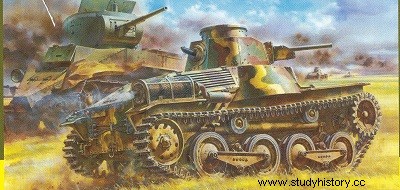
Type: light tank.
Crew: 3 men.
Armament: a 37 mm Type 94 gun; a 6.5 mm Type 91 machine gun at the front of the hull (see text).
Armor:
minimum 6 mm,
maximum 12mm.
Dimensions:
length: 4.38 m;
width: 2.05m;
height: 218 m.
Weight in combat order: 7.4 t.
Ground pressure: 0.61 kg/cm2.
Engine: Mitsubishi Model NVD 6120 6 cyl. air-cooled diesel, developing 121 hp at 1,800 rpm.
Performance:
road speed: 45 km/h:
range: 250 km;
vertical obstacle 0.81 m;
clean cut: 2 m:
slope: 60%.
Service time: in the Japanese army from 1935 to 1945:
In 1934, the Mitsubishi factories built the prototype of a new light tank, which was tested in China and Japan and was followed by a second prototype in 1935. The latter was standardized under the name of Type 95 light tank but it was was also called Ha-Go (name given by Mitsubishi) or Ke-Go (his official name in the army). Although, according to most sources, the prototype was built by Mitsubishi, some claim that it was produced at the Sagami arsenal.
Used by the cavalry and the infantry, the Type 95 fought in China and throughout the Second World War Production reached approximately 1,250 units, most of which were built by Mitsubishi; various other companies and arsenals also participated in the manufacture of different elements of the tank.
Originally, the Type 95 was worth many other light tanks of the time, but by the start of the Second World War, it was already outdated, like most Japanese armored vehicles. The Japanese used the Type 95s in small units or wasted them assigning them a static defense role in the many Pacific islands they had invaded.
The hull was a riveted and wrought structure whose thickness varied from 9 to 14 mm. The driver was at the front right, the bow gunner to his left. The tank commander. which was also to load and serve the gun, was in the turret offset on the left of the hull. Engine and transmission were in the back and the crew could reach the engine from inside.
The combat chamber was padded with asbestos, both to keep the interior temperature as low as possible and to offer the crew some protection against injuries they might incur when the tank was moving over very rough terrain.
A space between the asbestos and the hull allowed air to circulate. Suspension. of the type with angled levers, had four road wheels (two per buggy with the sprocket at the front and the tensioning wheel at the rear, there were two support rollers.
On some of the Type 95s used in Manchuria, the suspension was modified because severe pitching was observed when the tank moved over the particularly rough terrain of this region. This modified model was called Type 35 (Special).
The armament included a 37 mm gun in the turret which could fire both high and anti-personnel shells, and a 6.5 mm Type 61 machine gun mounted at the front of the hull, with an azimuth shot of 350 left as on the right. Later, the gun was replaced by a 7.7 mm Type 97 machine gun and a similar weapon was mounted in the turret, pointed at 5 o'clock. This was operated by the tank commander. At a later stage of the war, the 37 mm Type 94 gun was replaced by a Type 98 gun with a higher muzzle velocity.
Ammunition load was 119 shells of 37 mm and 2,970 rounds. Some tanks also carried smoke launchers on the sides of the hull, facing the rear.
There were several variants of this light tank, including an amphibious version described elsewhere.
In 1944, some Type 95s had their 37 mm gun replaced by the 57 mm gun that armed the Type 97 medium tank. These vehicles were then called Type 3 light tanks.
These were followed, in 1944, by the Type 4, a Type 95 whose standard turret had been replaced by the complete turret of the Type 97 medium tank, with its 47 mm gun. The Type 95 should have succeeded the Type 98 light tank, whose prototypes built by Hino Motors and Mitsubishi were completed as early as 1938. This tank was not put into production until 1942 and it seems that only 100 were built. (200, according to some sources) until production ceased in 1943.
This model had a more powerful engine which gave it greater speed and it featured a thicker armor. Its suspension consisted of six road wheels, with the sprocket at the front, the tensioning wheel at the rear and three support rollers. The driver was in the front center of the hull.
Armament included a 37mm Type 100 cannon and two 7.7mm Type 97 machine guns.
Other Japanese light tanks included the Improved Model 98, which had four road wheels, the tension wheel at the front and the sprocket at the rear. It had no support rollers, the track resting directly on the road wheels. Finally, there was the Type 2 (less than 30 built) and the Type 5, only one of which was built by Hino Motors before the end of the war.
